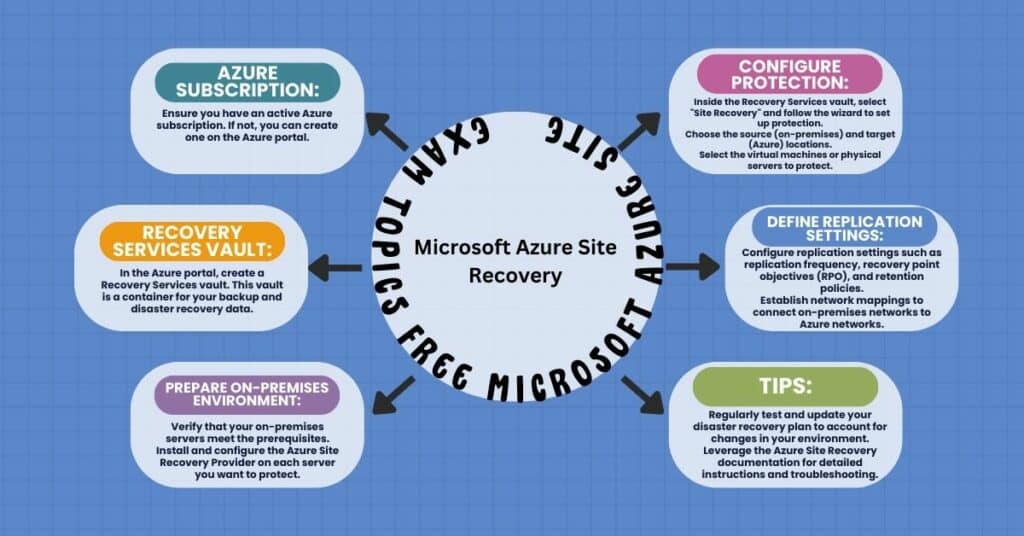Introduction to Azure Site Recovery
Welcome to the world of Azure Site Recovery, where seamless data protection and disaster recovery solutions meet cutting-edge technology. In today’s fast-paced digital landscape, safeguarding your systems and ensuring business continuity are paramount. Join us as we delve into the best practices for configuring Azure Site Recovery in 2024 to keep your operations running smoothly and securely. Let’s explore how this innovative tool can be a game-changer for your organization’s resilience strategy.
The Importance of Disaster Recovery Planning
Disaster recovery planning is a critical aspect of any organization’s business continuity strategy. It involves preparing for unforeseen events that could disrupt normal operations, such as natural disasters, cyber-attacks, or hardware failures.
Having a well-thought-out disaster recovery plan in place can help minimize downtime and data loss in the event of a disaster. It enables businesses to quickly recover and resume operations without significant disruptions to their services or customer experience.
By proactively planning for potential disasters, organizations can ensure the safety and security of their data, applications, and infrastructure. This proactive approach not only safeguards valuable assets but also protects the organization’s reputation and credibility among stakeholders.
In today’s digital age where threats are constantly evolving, investing time and resources into disaster recovery planning is no longer optional—it’s essential for long-term sustainability and success.
=> Click to Place Your Order at the Best Available Price ✅

Best Practices for Configuring Azure Site Recovery
When it comes to configuring Azure Site Recovery for your business, there are several best practices that can ensure a smooth and efficient process.
Carefully assess your organization’s specific needs and requirements before setting up Azure Site Recovery. This step will help tailor the configuration to suit your unique environment.
Next, establish clear recovery goals and objectives to determine the level of protection needed for each workload or application. Mapping out these priorities will guide you in configuring Azure Site Recovery effectively.
Regularly test failover scenarios to validate the configuration and identify any potential issues before an actual disaster occurs. This practice helps in fine-tuning the setup for optimal performance during real-world events.
Document all configurations and settings meticulously to maintain a comprehensive record of your Azure Site Recovery setup. This documentation is crucial for troubleshooting, auditing, and future reference.
Azure Site Recovery Provides for Virtual Machines
Azure Site Recovery offers a seamless solution for protecting and recovering virtual machines in the event of a disaster. By replicating your VMs to Azure, you can ensure business continuity and minimize downtime.
With Azure Site Recovery, you have the flexibility to replicate VMs from on-premises environments, other cloud providers, or even within Azure itself. This versatility makes it an ideal choice for organizations with diverse IT infrastructures.
In addition to disaster recovery capabilities, Azure Site Recovery also allows for non-disruptive testing of failover scenarios. This feature enables you to validate your recovery plans without impacting production workloads.
By leveraging the automation capabilities of Azure Site Recovery, you can simplify the management of VM replication and failover processes. This automation not only saves time but also reduces the risk of human error during critical operations.
Azure Site Recovery provides a robust platform for safeguarding your virtual machines and ensuring continuous operation in any unforeseen circumstances.
=> Click to Place Your Order at the Best Available Price ✅
Ensuring Data Security with Azure Site Recovery
Data security is a top priority for organizations leveraging Azure Site Recovery. When it comes to safeguarding critical information, encryption plays a vital role in securing data both at rest and in transit. By utilizing Azure’s robust encryption capabilities, businesses can ensure that their data remains protected against unauthorized access.
Additionally, implementing multi-factor authentication (MFA) adds an extra layer of security by requiring users to verify their identity through multiple methods before gaining access to sensitive data. This helps prevent unauthorized individuals from compromising the system.
Regularly auditing and monitoring user activity within Azure Site Recovery is essential for detecting any suspicious behavior or potential security threats promptly. By staying vigilant and proactively addressing any anomalies, organizations can maintain a strong defense against cyberattacks.
Moreover, conducting regular backups of critical data ensures that even in the event of a breach or disaster, businesses can recover their information quickly without experiencing significant downtime or loss. With these proactive measures in place, organizations can enhance their overall data security posture while leveraging the benefits of Azure Site Recovery seamlessly.
Monitoring and Maintaining Azure Site Recovery
Monitoring and maintaining Azure Site Recovery is crucial to ensure the continuous protection of your data and applications. Regularly monitoring the replication health status allows you to identify any issues promptly and take corrective actions. Setting up alerts for critical events can help you stay informed about potential disruptions.
It’s essential to regularly review recovery plans and perform test failovers to validate their effectiveness. This proactive approach ensures that your disaster recovery strategy remains reliable in case of an actual outage. Monitoring the performance metrics of your virtual machines helps optimize resource utilization and identify any bottlenecks.
Regularly updating Azure Site Recovery components keeps the solution secure and up-to-date with the latest features and enhancements. Conducting periodic drills and simulations prepares your team for swift response during a real disaster scenario, minimizing downtime and data loss.
Incorporating automation where possible streamlines monitoring processes, allowing for quicker detection and resolution of issues. By staying vigilant in monitoring and maintaining Azure Site Recovery, you can ensure business continuity even in challenging circumstances.
Cost Optimization Strategies for Azure Site Recovery
Managing costs effectively is key when implementing Azure Site Recovery. One cost optimization strategy to consider is leveraging the “pay-as-you-go” model, allowing you to only pay for what you use. Additionally, optimizing storage costs by utilizing Azure Blob Storage for long-term retention can result in significant savings.
Another way to optimize costs is by carefully selecting the replication options that best suit your needs. Choosing between standard and premium storage tiers based on recovery time objectives and performance requirements can help reduce unnecessary expenses.
Regularly reviewing and adjusting your configuration settings can also aid in cost optimization. By monitoring resource utilization and making adjustments as needed, you can ensure efficient use of resources while keeping costs in check.
Furthermore, taking advantage of reserved instances or spot instances where applicable can further drive down costs without compromising on performance or reliability. Implementing these strategies proactively will help maximize the value of Azure Site Recovery while minimizing expenses.
Real-World Examples and Success Stories
Imagine a manufacturing company that faced a sudden server outage, disrupting its production line. With Azure Site Recovery in place, the company seamlessly failed over to virtual machines in the cloud, minimizing downtime and ensuring business continuity.
In another scenario, a financial institution experienced a cyber attack leading to data corruption. Thanks to Azure Site Recovery’s robust disaster recovery capabilities, the institution quickly recovered its critical data from replicated backups without any loss or compromise.
Furthermore, an e-commerce platform encountered unexpected hardware failure on-premises during peak shopping season. By leveraging Azure Site Recovery for automated failover and failback processes, the platform maintained uninterrupted service delivery to customers without impacting sales revenue.
These real-world examples highlight how businesses across various industries have successfully utilized Azure Site Recovery to safeguard their operations and uphold customer trust amidst unforeseen challenges.
Future Outlook for Azure Site Recovery in 2024
As we look ahead to the future of Azure Site Recovery in 2024, exciting advancements and enhancements are on the horizon. With technology evolving rapidly, Azure is expected to continue innovating its disaster recovery solutions to meet the changing needs of businesses worldwide.
In 2024, we can anticipate Azure Site Recovery further integrating with other Microsoft cloud services, offering more seamless and comprehensive data protection capabilities for organizations of all sizes. Enhanced automation features will streamline disaster recovery processes even further, reducing manual intervention and ensuring faster recovery times in case of an outage.
Moreover, AI and machine learning technologies are likely to be leveraged within Azure Site Recovery to provide predictive analytics and proactive monitoring, enabling preemptive actions to mitigate potential risks before they escalate into full-blown disasters.
The future outlook for Azure Site Recovery in 2024 appears promising as it continues to adapt and evolve alongside technological advancements in the ever-changing digital landscape.
Conclusion
Azure Site Recovery is a powerful tool that can help businesses of all sizes protect their data and applications in the event of a disaster. By following best practices for configuring, monitoring, and maintaining Azure Site Recovery, organizations can ensure that they are prepared to handle any unexpected challenges that may arise.
With features like virtual machine support, data security measures, and cost optimization strategies, Azure Site Recovery offers comprehensive protection for critical workloads. Real-world examples and success stories demonstrate the effectiveness of this solution in action.
Looking ahead to 2024, Azure-Site Recovery continues to evolve with new capabilities and enhancements. As technology advances and threats evolve, it is essential for businesses to stay proactive in their disaster recovery planning. By incorporating Azure Site Recovery into their overall IT strategy, organizations can mitigate risks, improve resilience, and safeguard their operations for the future. Embracing these best practices will not only enhance data protection but also contribute to a more robust business continuity framework.






0 Comments